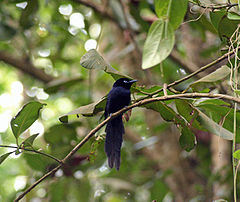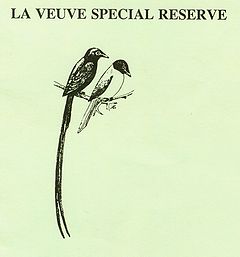
Seychelles Paradise-Flycatcher
Encyclopedia


Terpsiphone
The paradise-flycatchers, Terpsiphone, are a genus of monarch flycatchers. The genus ranges across Africa and Asia, as well as a number of islands. A few species are migratory, but the majority are resident. The most telling characteristic of the genus is the long tail streamers of the males of...
) within the family Monarchidae. It is endemic to the Seychelles
Seychelles
Seychelles , officially the Republic of Seychelles , is an island country spanning an archipelago of 115 islands in the Indian Ocean, some east of mainland Africa, northeast of the island of Madagascar....
.
Description
The length of the males is about 20 cm. In addition there are two long black central tail feathers which can reach a length of 30 cm. The females can reach a length between 16 and 18 cm (including the tail). The males are entirely glossy black with a deep blue sheen. The upperparts of the females including wings and tail are reddish brown. The underparts are pale cream white. Facial skin, bill, and legs are blue.Distribution
It lives in the Veuve Nature Reserve on La DigueLa Digue
La Digue is the fourth largest inhabited island of the Seychelles, lying east of Praslin and west of Felicite Island. It has a population of about 2,000 people, who mostly live in the west coast villages of La Passe and La Réunion. It has an area of 10 km²...
, Seychelles
Seychelles
Seychelles , officially the Republic of Seychelles , is an island country spanning an archipelago of 115 islands in the Indian Ocean, some east of mainland Africa, northeast of the island of Madagascar....
, where it inhabits dense Calophyllum
Calophyllum
Calophyllum is a flowering plant genus of around 180-200 species of tropical evergreen trees in the family Calophyllaceae. The generic name is derived from the Greek words καλος , meaning "beautiful", and φυλλον , meaning "leaf." Its members are native to Australasia, Madagascar, Eastern Africa,...
forests.

